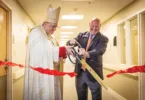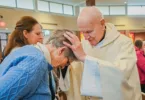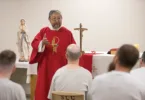by Joe Bollig
KANSAS CITY, Kan. — Any Boy Scout can tell you that if you don’t bring a map and compass, you might get lost in the woods.
The same could be said of a parish and its future. Change happens, and without a plan for the future, a parish can get “lost” in the challenges the future inevitably brings.
That’s why the various regions of the archdiocese began pastoral planning in 2005. In January, the Southern Region began the pastoral planning process, and it was joined in July by two parish clusters in the Topeka and Lawrence regions.
“[The purpose of pastoral planning] is to be proactive, and not reactive, to the needs of our communities,” said Alan Meitler, senior consultant and vice president of the Wisconsin-based Meitler Consultants. He has worked with other archdiocesan regions on their plans.
The all-critical ingredient in pastoral planning is participation by parishioners, said Carroll Macke, former archdiocesan consultant for communications and planning.
“I think the purpose of long-range pastoral planning is to have input from parishioners who live in the region about the future of the church in their region and the archdiocese,” said Macke, who continues to assist archdiocesan pastoral planning as a consultant.
“The archbishop has recommended planning for five to 10 years down the road, and these plans will have to be revisited because things change,” he continued. “You have to have a plan on paper to prepare for what will happen, and not react in knee-jerk fashion.”
The basic question asked in regional pastoral planning is how can the region make the best use of physical resources (churches, schools, rectories, and other buildings) and human resources (pastors, parish staff, and volunteers) both now and for the future, said Macke.
One factor that makes the current process slightly different from others in the past is that it is being done after the boundaries of the pastoral regions were redrawn in 2008, reducing the number of regions from 11 to eight.
With these changes, the Southern Region became one of the largest in the archdiocese in terms of geographical area, as did the Topeka Region. Now the Southern Region is comprised of 19 parishes (counting the Didde Catholic Campus Center in Emporia) and 10 pastors.
At the same time, two parish clusters are conducting parallel but separate pastoral planning.
The first, in the Topeka Region, is the tri-parish community of St. Francis of Assisi in Lapeer (48 families), St. Patrick in Osage City (212 families), and St. Patrick in Scranton (148 families) — all three share Father Anthony Ouellette as pastor.
The second, in the Lawrence Region, is Annunciation in Baldwin (215 families) and Assumption in Edgerton (75 families); Father Brandon Farrar is pastor of both parishes.
Father Ouellette’s parishes are planning now because they were part of the former Emporia Region and didn’t participate in the Topeka Region’s original plan.
Father Farrar’s parishes are planning now because they don’t fit neatly into the Lawrence Region due to geography and demographics, he said. Also, due to the fact that the Lawrence Region is small and that the parishes are quite different from each other, planning will be done on a parish level instead of region-wide.
The planning process begins with information gathering by the consultant. This includes visits to the parish and with the pastor. The next step is a meeting with the consultant and lay leaders of the parish. After this, two parishioners from each parish are chosen to be on a task force. That group will solicit information from the pastor and lay leaders, and begin to formulate a plan.
Since they are not part of the Southern Region, representatives from the parishes led by Father Ouellette and Father Farrar will form their own task force. At some point, either the Southern Region or the two parish clusters could solicit input from all parishioners. A final review and recommendations could go to the archbishop this coming January or February.
“The process is an opportunity for any parish to take a very sober look at themselves — where they’ve been in the past, and where they want to be in the future,” said Father Ouellette.






